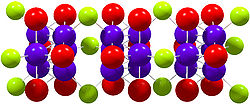- Molecular wire
-
Part of a series of articles on
Single-molecule electronics Molecular scale electronics
Molecular logic gate
Molecular wiresSolid state nanoelectronics Related approaches See also
Nanotechnology
Molecular wires (or sometimes called molecular nanowires) are molecular-scale objects which conduct electrical current. They are the fundamental building blocks for molecular electronic devices. Their typical diameters are less than three nanometers, while their bulk lengths may be macroscopic, extending to centimeters or more.
Contents
Materials
The most common types of molecular wires are based on organic molecules. Higher conductivities originate from highly conjugated systems, while alkane chains are important in understanding basic charge transport and tunneling. A molecular wire occurring in nature is DNA, but it is believed not to conduct in natural form, and while doping studies have so far not produced convincing long-range conductivity in DNA wires, research into producing conducting DNA has been quite intense. Prominent inorganic examples include polymeric materials such as Li2Mo6Se6[1] and Mo6S9-xIx,[2][3][4] and single-molecule extended metal atom chains (EMACs) which comprise strings of transition metal atoms directly bonded to each other.[5] Molecular wires containing paramagnetic inorganic moieties are interesting, in particular, because they can lead to observations of Kondo peaks.
Structure
Unlike the more usual nanowires (which are very thin crystals), molecular nanowires are composed of repeating molecular units, which may be organic (e.g. DNA) or inorganic (e.g. Mo6S9-xIx). In the case of DNA, the repeat units are the nucleotides with a backbone made of sugars and phosphate groups joined by ester bonds. Attached to each sugar is one of four types of bases. In case of Mo6S9-xIx, the repeat units are Mo6S9-xIx clusters, which are joined together by flexible sulfur or iodine bridges. Molecular nanowires can be manipulated and investigated as single molecules, but often aggregate in solution into swatches or bundles. In the case of the Mo chalcogenide-halides, they grow in the form of ordered strands, in which the individual strands are linked by very weak Van der Waals forces. Individual molecules can be manipulated, ordered and their length can be controlled with atomic force microsope tips. EMAC molecular wires consist of distinct molecules whose length can be controlled on the atomic scale.
Conduction of electrons
Molecular wires conduct electricity. They typically have non-linear current-voltage characteristics, and do not behave as simple ohmic conductors. The conductance follows typical power law behavior as a function of temperature or electric field, whichever is the greater, arising from their strong one-dimensional character. Numerous theoretical ideas have been used in an attempt to understand the conductivity of one-dimensional systems, where strong interactions between electrons lead to departures from normal metallic (Fermi liquid) behavior. Important concepts are those introduced by Tomonaga, Luttinger and Wigner. Effects caused by classical Coulomb repulsion (called Coulomb blockade), interactions with vibrational degrees of freedom (called phonons) and Quantum Decoherence [6] have also been found to be important in determining the properties of molecular wires.
Use of nanowires in molecular electronics
To be of use for connecting molecules together, MWs need to display some very important characteristics. The connectors between elements need to be able to self-assemble following well-defined routes and form reliable electrical contacts between them. To reproducibly self-assemble a complex circuit based on single molecules, it is essential that the connectors which join them have recognitive ability. They should be able to connect to diverse materials, such as gold metal surfaces (for connections to outside world), biomolecules (for nanosensors, nanoelectrodes, molecular switches) and most importantly, they must allow branching. The connectors should also be available of pre-determined diameter and length. They should also have covalent bonding to ensure reproducible transport and contact properties. DNA-like molecules have specific molecular-scale recognition and can be used very effectively in molecular scaffold fabrication. Very complex shapes have recently been demonstrated, but unfortunately metal coated DNA which is electrically conducting is much too thick to connect to individual molecules. Thinner coated DNA lacks electronic connectivity, and are not suitable for connecting molecular electronics elements. Some varieties of carbon nanotubes (CNTs) are conducting, and connectivity at their ends can be achieved by attachment of connecting groups. Unfortunately manufacturing CNTs with pre-determined properties is impossible at present, and the functionalized ends are typically not conducting, limiting their usefulness as molecular connectors. Individual CNTs can be soldered in an electron microscope, but the contact is not covalent and cannot be self-assembled. Recently possible routes for the construction of larger functional circuits using Mo6S9-xIx MWs have been demonstrated, either via gold nanoparticles as linkers, or by direct connection to thiolated molecules. The two approaches may lead to different possible applications. The use of GNPs offers the possibility of branching and construction of larger circuits.
Other uses
Molecular wires can be incorporated into polymers, enhancing their mechanical and/or conducting properties. The enhancement of these properties relies on uniform dispersion of the wires into the host polymer. Recent advances in the use of MoSI wires have been made in such composites, relying on their superior solubility within the polymer host compared to other nanowires or nanotubes. Bundles of wires can be used to enhance tribological properties of polymers, with applications in actuators and potentiometers.
References
- ^ J.M. Tarascon, G.W. Hull and F.J. Di Salvo (1984). Mater. Res. Bull. 19: 915.
- ^ D. Vrbanic et al. (2004). "Air-stable monodispersed Mo6S3I6 nanowires". Nanotechnology 15: 635–638. doi:10.1088/0957-4484/15/5/039.
- ^ C. Perrin and M. Sergent (1983). J. Chem. Res. 5: 38–39.
- ^ D. Mihailovic (2009). "Inorganic molecular wires: Physical and functional properties of transition metal chalco-halide polymers". Progress in Materials Science 54: 309–350. doi:10.1016/j.pmatsci.2008.09.001.
- ^ F. Albert Cotton, Carlos A. Murillo and Richard A. Walton (2005). Multiple Bonds Between Metal Atoms (3 ed.). Springer. pp. 669–706. ISBN 0387258299.
- ^ Cattena, C. J.; Bustos-Marun, R. A.; Pastawski, H. M. (2010). "Crucial role of decoherence for electronic transport in molecular wires: Polyaniline as a case study". Physical Review B 82 (14): 144201. doi:10.1103/PhysRevB.82.144201.
External links
Categories:- Molybdenum compounds
- Sulfides
- Semiconductor materials
- Nanotechnology
Wikimedia Foundation. 2010.

